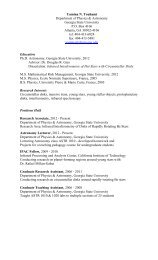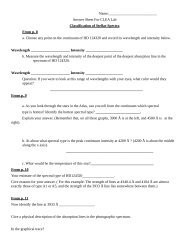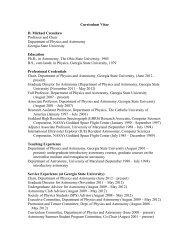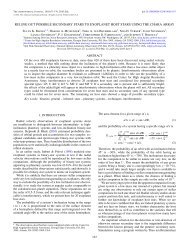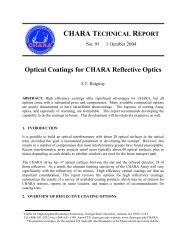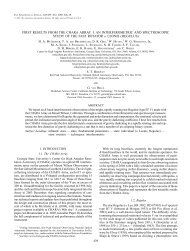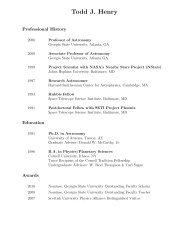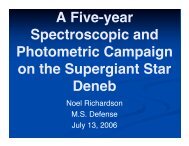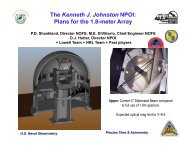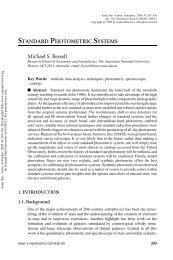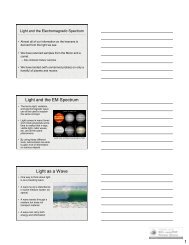FIRST ASSIGNMENT: PHYSICS 8120 PLASMA PHYSICS: DUE 10 ...
FIRST ASSIGNMENT: PHYSICS 8120 PLASMA PHYSICS: DUE 10 ...
FIRST ASSIGNMENT: PHYSICS 8120 PLASMA PHYSICS: DUE 10 ...
You also want an ePaper? Increase the reach of your titles
YUMPU automatically turns print PDFs into web optimized ePapers that Google loves.
<strong>FIRST</strong> <strong>ASSIGNMENT</strong>: <strong>PHYSICS</strong> <strong>8120</strong><br />
<strong>PLASMA</strong> <strong>PHYSICS</strong>: <strong>DUE</strong> <strong>10</strong> SEPTEMBER 2007<br />
Prof. Paul J. Wiita<br />
If you haven’t already done so, read Chapters 1 and 2 in the Kulsrud text. Problem numbers<br />
below refer to this book. The numbers in brackets after each question denote its point value.<br />
The assignment is due at the beginning of class on Sept. <strong>10</strong>th. I hope to have the<br />
graded assignment back to you by the 12th, but will certainly have them returned by the 17th.<br />
If you hand your paper in late, 5 points will be subtracted for every hour after 11:00 AM on<br />
the <strong>10</strong>th that it is received.<br />
Before doing the problems, please note SOME ERRATA I found in the text and correct your<br />
copy accordingly:<br />
p. 4, para. 2, l. 5: add η: ... the resistivitiy, η, is the ...<br />
p. <strong>10</strong>, Eq. <strong>10</strong>: the δ in the denominator should be the number 8<br />
p. 29, 4th para, penultimate and antepenultimate lines:<br />
Add and subtract question marks: .... moment µ change? The answer is no. ...<br />
p. 32, 3rd para, 3rd line: DELETE “is”<br />
p. 36, Eq. 49 The B in the denominator should have the subscript C, i.e, B C .<br />
If you find any others, you will get one bonus point on this assignment for every<br />
typo and grammatical error and three bonus points for every error in an equation<br />
or mathematical point you detect.<br />
1. Using Saha’s equation, plot the fractional ionization, p = [n i /n m ] as a function of temperature,<br />
T, for at least four values of the total density n T = n i + n m . Determine the ratio p at<br />
T = <strong>10</strong> 4 K and n T = <strong>10</strong> 21 cm −3 . Note that the constant in the form of this equation in the<br />
notes changes to 2.4 × <strong>10</strong> 15 if densities are in units of cm −3 instead of m −3 [<strong>10</strong>]<br />
2. Estimate the number of particles in a Debye sphere for the following plasmas: (a) the earth’s<br />
ionosphere; (b) the solar corona; (c) cometary tails; (d) an H II region near a hot star;<br />
(e) the warm phase of the interstellar medium; (f) the hot, coronal phase of the ISM;<br />
(g) the intracluster medium of a cluster of galaxies. (The plot on p. 6 of the notes will<br />
be helpful, but you’ll need to to a little research to find appropriate numbers.) [14]<br />
3. Show that, as mentioned in class, in the case of an inhomogenous magnetic field:<br />
v D<br />
= a ∇ ⊥B<br />
v ⊥ 2B<br />
[12]<br />
4. Chapter 2, Problem 1 [15]<br />
5. Consider the non-relativistic motion of particles of charge q and mass m in crossed static<br />
electric and magnetic fields. Take the electric field to be ⃗ E = (0, Eĵ, 0) and the magnetic<br />
field to be ⃗ B = (0, 0, Bˆk) (in Cartesian coordinates).<br />
(a) Assuming that q, B, and E are all positive, sketch the orbit of a typical particle. [4]<br />
(b) For the particular case that a particle is initially at rest at the origin, determine the form<br />
of the orbit. Is this an example of the ‘typical’ particle you considered in (a)? [4]<br />
1
6. A charged particle executing circular motion in a uniform magnetic field constitutes a current<br />
loop. Show that this current loop produces a magnetic field in a direction opposite to<br />
the original field. [<strong>10</strong>]<br />
7. Determine the motion of a relativistic charged particle that obeys the equation:<br />
d⃗p<br />
dt = q c ⃗v × ⃗ B,<br />
where ⃗p = γm⃗v and the Lorentz factor, γ = (1 − v 2 /c 2 ) −1/2 . Assume ⃗ B is constant and<br />
⃗E = 0. [14]<br />
8. Chapter 2, Problem 2 [17]<br />
You may collaborate, if necessary, on Problems 3, 4, 7 and 8. If you do so, be sure to<br />
list the names of those collaborators at the top of the first page of your solutions.<br />
2



